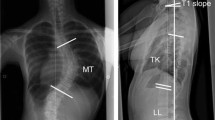Abstract
Purpose
Cervical spine alignment interests appeared recently and relationships between the pelvis and the cervical spine have been reported but remain unclear. In this study, postoperative changes for cranial, cervical, lumbar and sagittal balance parameters have been measured in adult scoliosis surgery without major sagittal malalignment to appreciate the adaptation of the cervical spine.
Methods
Twenty-nine consecutive patients with a surgical adult degenerative scoliosis treated with a T8–T11 to iliac fusion without PSO or multiple Ponte’s osteotomies had preoperative and postoperative full spine EOS radiographies to measure spino-pelvic parameters. Correlation analysis between the different parameters was performed.
Results
Lower cervical, lordosis, lumbar lordosis and thoracic kyphosis were increased in postoperative as no changes were observed for upper cervical lordosis. C1–C7 CL highly correlated (0.85 in preoperative and 0.87 in postoperative) with C7 slope, which highly correlated itself with global balance parameters (0.74 in preoperative and 0.71 in postoperative for CAM-PL) underlining the relationship between cervical spine alignment and global malalignment.
Conclusions
Modifications of lower CL are observed, as upper CL remains constant. If no correlation was found for LL, TK and CL changes, CL appears to be highly correlated with C7 slope, which highly correlated itself with sagittal global balance parameters. C7 slope appears as a base for CL influenced by the spine global alignment.

Similar content being viewed by others
References
Boissiere L, Bourghli A, Vital JM, Gille O, Obeid I (2013) The lumbar lordosis index: a new ratio to detect spinal malalignment with a therapeutic impact for sagittal balance correction decisions in adult scoliosis surgery. Eur Spine J. doi:10.1007/s00586-013-2711-y
Duval-Beaupère G (2004) Composante sagittale de la statique rachidienne Revue de. Rhumatologie 71:115–119
Gay RE (1993) The curve of the cervical spine: variations and significance. J Manip Physiol Ther 16(9):591–594
Gore DR, Sepic SB, Gardner GM (1986) Roentgenographic findings of the cervical spine in asymptomatic people. Spine (Phila Pa 1976) 11(6):521–524
Takeshima T, Omokawa S, Takaoka T, Araki M, Ueda Y, Takakura Y (2002) Sagittal alignment of cervical flexion and extension: lateral radiographic analysis. Spine (Phila Pa 1976) 27(15):E348–E355
Lee SH, Kim KT, Seo EM, Suk KS, Kwack YH, Son ES (2012) The influence of thoracic inlet alignment on the craniocervical sagittal balance in asymptomatic adults. J Spinal Disord Tech 25(2):E41–E47. doi:10.1097/BSD.0b013e3182396301
Hardacker JW, Shuford RF, Capicotto PN, Pryor PW (1997) Radiographic standing cervical segmental alignment in adult volunteers without neck symptoms. Spine (Phila Pa 1976) 22(13):1472–1480 (discussion 1480)
Demezon H (2012) Paramètres Globaux de Référence du Rachis Calcules sur des Sujets Asymptomatiques par Imagerie EOS. Thèse de Médecinen°3042 Université Bordeaus 2
Smith JS, Shaffrey CI, Lafage V, Blondel B, Schwab F, Hostin R, Hart R, O’Shaughnessy B, Bess S, Hu SS, Deviren V, Ames CP (2012) Spontaneous improvement of cervical alignment after correction of global sagittal balance following pedicle subtraction osteotomy. J Neurosurg Spine 17(4):300–307. doi:10.3171/2012.6.SPINE1250
Arlet V, Aebi M (2013) Junctional spinal disorders in operated adult spinal deformities: present understanding and future perspectives. Eur Spine J 22(Suppl 2):S276–S295. doi:10.1007/s00586-013-2676-x
Dubousset J, Charpak G, Skalli W, Kalifa G, Lazennec JY (2007) EOS stereo-radiography system: whole-body simultaneous anteroposterior and lateral radiographs with very low radiation dose. Rev Chir Orthop Repar Appar Mot 93(6 Suppl):141–143
Champain S, Benchikh K, Nogier A, Mazel C, Guise JD, Skalli W (2006) Validation of new clinical quantitative analysis software applicable in spine orthopaedic studies. Eur Spine J 15(6):982–991. doi:10.1007/s00586-005-0927-1
Gangnet N, Pomero V, Dumas R, Skalli W, Vital JM (2003) Variability of the spine and pelvis location with respect to the gravity line: a three-dimensional stereoradiographic study using a force platform. Surg Radiol Anat 25(5–6):424–433. doi:10.1007/s00276-003-0154-6
Ilharreborde B, Vidal C, Skalli W, Mazda K (2013) Sagittal alignment of the cervical spine in adolescent idiopathic scoliosis treated by posteromedial translation. Eur Spine J 22(2):330–337. doi:10.1007/s00586-012-2493-7
Nojiri K, Matsumoto M, Chiba K, Maruiwa H, Nakamura M, Nishizawa T, Toyama Y (2003) Relationship between alignment of upper and lower cervical spine in asymptomatic individuals. J Neurosurg 99(1 Suppl):80–83
Penning L (1978) Normal movements of the cervical spine. Am J Roentgenol 130(2):317–326. doi:10.2214/ajr.130.2.317
Kim TH, Lee SY, Kim YC, Park MS, Kim SW (2013) T1 slope as a predictor of kyphotic alignment change after laminoplasty in patients with cervical myelopathy. Spine (Phila Pa 1976) 38(16):E992–E997. doi:10.1097/BRS.0b013e3182972e1b
Yu M, Silvestre C, Mouton T, Rachkidi R, Zeng L, Roussouly P (2013) Analysis of the cervical spine sagittal alignment in young idiopathic scoliosis: a morphological classification of 120 cases Eur. Spine J. doi:10.1007/s00586-013-2753-1
Vital JM, Senegas J (1986) Anatomical bases of the study of the constraints to which the cervical spine is subject in the sagittal plane. A study of the center of gravity of the head. Surg Radiol Anat 8(3):169–173
Conflict of interest
The authors declare that they have no conflict of interest.
Author information
Authors and Affiliations
Corresponding author
Rights and permissions
About this article
Cite this article
Boissière, L., Bernard, J., Vital, JM. et al. Cervical spine balance: postoperative radiologic changes in adult scoliosis surgery. Eur Spine J 24, 1356–1361 (2015). https://doi.org/10.1007/s00586-015-3854-9
Received:
Revised:
Accepted:
Published:
Issue Date:
DOI: https://doi.org/10.1007/s00586-015-3854-9




